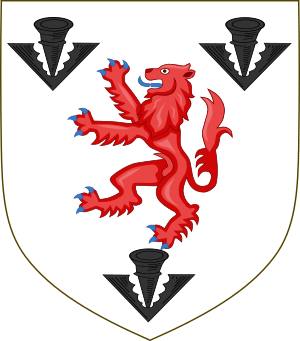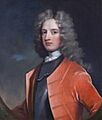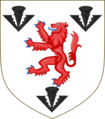William Egerton (politician, died 1732) facts for kids
Quick facts for kids
The Honourable
William Egerton
|
|
|---|---|

Egerton, by Charles Jervas
|
|
| Member of Parliament for Brackley |
|
| In office 1708–1714 |
|
| Member of Parliament for Brackley |
|
| In office 1715–1732 |
|
| Military service | |
| Allegiance | Kingdom of Great Britain |
| Branch/service | British Army |
| Rank | Colonel |
| Unit | 6th Regiment of Foot 1st Foot Guards |
William Egerton (1684–1732) was an important figure in British history. He was an officer in the British Army and a Whig politician. He served as a Member of Parliament (MP) in the British House of Commons for many years, from 1706 to 1732.
Contents
Early Life and Military Beginnings
William Egerton was born in 1684. He was the fourth son of John Egerton, 3rd Earl of Bridgwater. His mother was Jane Paulet. She was the daughter of Charles Paulet, 1st Duke of Bolton.
As a young man, William traveled to Germany. After his travels, he joined the army. By 1704, he was a captain in the 6th Regiment of Foot. The next year, in 1705, he became a captain and lieutenant in the 1st Foot Guards.
A Career in Politics
William Egerton became a Member of Parliament (MP) in 1706. He was elected for Buckinghamshire without anyone running against him. This happened in a special election called a by-election.
Representing Brackley
In the 1708 British general election, William was again elected without opposition. This time, he represented the area of Brackley. He was a member of the Whig party.
At first, he was not very active in Parliament. This was because he was serving with the army in a place called Flanders. In 1710, he voted to impeach Dr. Sacheverell. Impeachment is a process to formally accuse a public official of wrongdoing.
Key Votes and Challenges
William was re-elected in the 1710 British general election. He voted for a motion called 'No Peace Without Spain'. This meant he wanted the war to continue until Spain was secured. On June 18, 1713, he voted against a bill about French trade.
In the 1713 British general election, he had to compete for his seat. He won the election. On March 18, 1714, he voted against expelling Richard Steele from Parliament.
Around April 1714, William was told by the Secretary at War that the Queen no longer needed his services. He was given 1,000 guineas. Soon after, he lost his seat in Parliament due to a petition.
Return to Parliament
After the Hanoverian royal family came to power, William Egerton's career continued. He was made a Colonel of his own infantry regiment. This regiment later became known as the 36th Regiment of Foot.
He was re-elected as MP for Brackley in the 1715 general election. Again, he faced no opposition. In 1719, he became Colonel of another regiment, which later became the 20th Regiment of Foot.
William was re-elected for Brackley in 1722 and 1727. He always voted with the government during his time in Parliament.
Family Life and Legacy
William Egerton passed away on July 15, 1732. He was married to Anna Maria Saunders. She was the daughter of Admiral Sir George Saunders. Admiral Saunders was a Commissioner of the Navy.
William and Anna Maria had three daughters. One of their daughters, Jane, married Thomas Revell. Thomas Revell was also an MP and lived at Fetcham Park.
Images for kids




